
Deepfreezing a Transmeta efficeon
By Van Smith
Date: May 17, 2004
Last weekend you could find in our deepfreeze, next to the Tony's Pizza, frozen garden vegetables, leftovers and Lean Cuisine, a $1500 Transmeta efficeon notebook running benchmarks. And guess what? Performance went up.
===================================
Blustery Bits
In our review of the Transmeta efficeon last month, we discovered persuasive indirect evidence suggesting that the Transmeta efficeon engaged in performance throttling with very little provocation. We decided to take a more direct approach to see if we could manipulate the efficeon's temperature to impact benchmark scores. We also wanted to simultaneously measure the efficeon's clock speed to make certain that the CPU frequency was actually changing along with performance.
Since the slick little Sharp Actius MM20 efficeon notebook boasts integrated 11g wireless networking built-in, we installed WinVNC (the system comes with WindowsXP Home and so does not have XP Pro's Remote Desktop server) so that we could control the system remotely through another computer. Although the freezer did weaken the wireless signal quite a bit, the link was still more than strong enough for a good WinVNC connection.
===================================
The Clock is Busted
We wanted to be able to measure the efficeon's clock speed in real time, but we soon discovered that our COSBI CPU Speed program that we wrote as well as other popular programs that report real-time clock speed (such as WCPUID) did not work properly with efficeon. All of these programs reported a constant 1GHz speed with efficeon.
We knew, however, that Transmeta exposed CPU frequency information through a CPUID call and that this call was working properly in COSBI OSMark. We reworked CPU Speed so that it would detect Transmeta processors and use Transmeta's CPUID function call to obtain the correct clock speed. As you can see below, COSBI CPU Speed now tracks the efficeon frequency transitions in real time as it should.
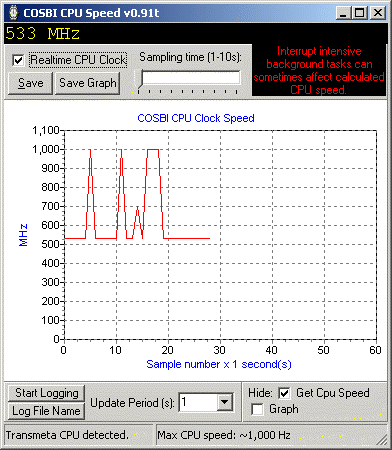
CPU clock frequencies are being tracked in COSBI CPU Speed.
Note the minor bug in the status bar.
Because the original CPU Speed program did not work properly, this likely means that there are at least a few programs that will be broken when running on the efficeon. All modern x86 microprocessors have counter mechanisms that are supposed to be incremented by one with each CPU cycle. A CPU cycle is sometimes referred to as a CPU "clock tick" and the number of elapsed CPU clock ticks is exposed through the x86 function call RDTSC. To measure the CPU clock frequency then only requires that a program obtain the number of clock ticks that have elapsed over a certain time period and then divide by the number of elapsed seconds.
But the efficeon updates RDTSC independently of the actual CPU clock speed and at a rate that corresponds to the maximum CPU frequency. This unconventional behavior will no doubt serve as a hard-to-isolate bug in some existing programs that assume that RDTSC only updates every CPU tick.
===================================
Outside the Freezer
Before we subjected the efficeon to the frosty insides of our deepfreeze, we ran our updated "WhetBurn" throttling test program alongside of our new CPU Speed program so that we could track the clock speed. For these tests, we repeatedly calculated and timed a 40th order Fibonacci sequence. A "Fib" sequence is a very simple and computationally undemanding recursive integer algorithm that is still sufficient to cause the efficeon to enter increasingly severe levels of thermal throttling. Doubtlessly, games, math, photo editing, encoding and many other applications will cause the efficeon to heat up much faster and hotter, but calculating a Fibonacci sequence works well enough for our purposes here.
Here is the Delphi 7 code for the Fibonacci function we used:
function Fibonacci( n : integer ) : integer;
begin
if n > 2 then begin
result := Fibonacci( n - 1 ) + Fibonacci( n - 2 )
end else begin
result := 1;
end; // if
end; // function Fibonacci( n : integer ) : integer;
In the picture below, you can see that the efficeon started throttling quickly.
The efficeon enters throttling by toggling the clock speed from 1GHz to 833MHz. After a little less than five minutes, the efficeon began to flatline at 833MHz. We have seen the efficeon throttle down to 533MHz under extreme conditions using more demanding programs, but 833MHz is what we were aiming for before sticking the efficeon notebook in the freezer.
Please try to excuse the poor quality of the screen shots. With four beautiful but energetic little daughters wanting attention and three literally climbing all over me most of the day, it is sometimes hard to take good snaphots at home.
===================================
Coldcut Computing
After a few seconds to make sure the efficeon system had stabilized at 833MHz, we then inserted the $1,500 efficeon notebook into our deepfreeze on top of the Tony's Pizza.
In a short time, performance began to improve.
We shut the freezer and when we came back several minutes later, the efficeon had returned to its maximum clock speed.
Here is a better look at the performance graph.
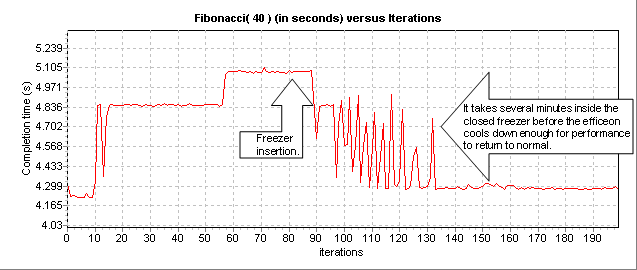
The results above prove beyond a reasonable doubt that the efficeon is engaging in heat related performance throttling. In other words, instead of using a fan to cool the CPU when it starts heating up, the efficeon slows itself down so that it does not fail because of high temperatures. These increasingly severe performance reduction measures occur under very light load and don't take very long to engage. It is also clear that if the efficeon had a better heating solution -- like one with a fan -- this throttling would not take place under normal loads.
To get the full 1GHz performance out of our efficeon notebook, we had to stick the little bugger in our freezer. We have verified that thermally related performance throttling was engaged on a second Sharp efficeon notebook, so we are confident that all Sharp Actius MM20 efficeon notebooks behave similarly.
It appears that Transmeta is actually selling 833MHz fanless efficeons as 1GHz fanless parts and relying upon performance throttling to keep the chips from overheating. The motivation for doing this is very clear: 1GHz fanless parts sell at a pronounced premium over either 833MHz fanless parts or 1GHz processors that need a fan.
===================================
In and Out of the Cold
We then ran a few quick benchmarks both inside and outside the freezer by using WinVNC to wirelessly remote control the Sharp Actius. We did this to see if there would be a performance difference that accompanied the ambient temperature.
After we took the notebook out of the freezer, we ran SuperPi three times in a row and recorded the scores. While the system was still warm, I ran downstairs, stuck the notebook back in the freezer, ran back upstairs and ran three SuperPi three more times. Here are the results.

The efficeon became slower on each consecutive run which is consistent with throttling occurring as the CPU heated up. Once inside the freezer and still warm, the efficeon was faster the longer it stayed in the cold, thus reducing thermal throttling.
The last benchmark that we ran inside the freezer through WinVNC was PCMark2002. Although we don't like this benchmark, we had previously installed it on this system so it was handy and many people are familiar with it. After this benchmark completed, we took the notebook out of the freezer, initiated WhetBurn to keep the system warm and wrapped the notebook in a baby blanket (we have lots of them around the house) to keep frost and condensation from forming.
Once the system stabilized at 833MHz, we then remotely killed WhetBurn and ran PCMark again. The system was still in the baby blanket to protect it from potential condensation, so this is close to a worst case run.
Finally, we let the system sit in our lab for a day, warmed it up to 833MHz with WhetBurn to simulate a system being used in the field, killled WhetBurn and then launched PCMark2002 again. Since these conditions are in the range of normalcy, we labeled these results "normal." The notebook was alone on a small wooden table and we made sure that there were no obstructions to any cooling vents. Keep in mind that WinVNC overhead is included in all of this data. Here is the chart.
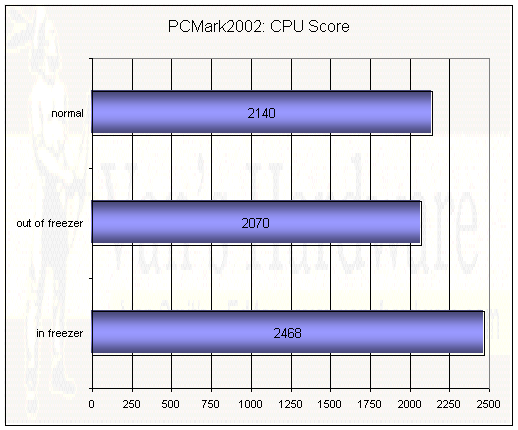
The efficeon was 20% faster than the "out of freezer" worst case run, but it was still more than 15% faster than the run that was conducted under very favorable conditions in our 75 degree Fahrenheit lab.
Here are the individual CPU test scores.
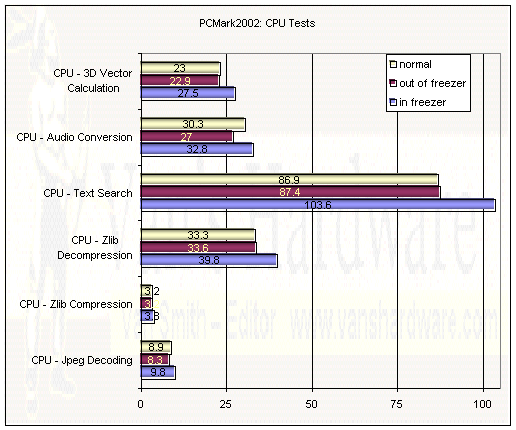
===================================
Hunting for Performance Throttling with Other Chips
We tried to find instances of similar performance throttling with other CPUs. Of course, we exclusively detailed the existence and nature of the P4 throttling apparatus years ago, so the P4 was a good place to start. We tried everything from 2.4GHz P4-Celerons to a 3GHz small form factor Dell, to a 3.4GHz HP. None of them throttled one iota on WhetBurn regardless of the test we threw at them. Below is a graph from a 2.53GHz Pentium 4 Dell system.

Intel's Banias has even more elaborate throttling machinery than the Pentium 4. We let the system run overnight with WhetBurn and the graph was perfectly flat.
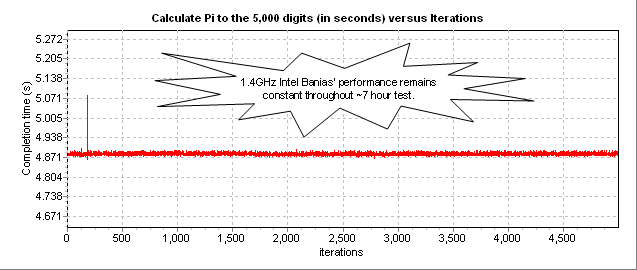
We tried several AMD systems including a few laptops and, as expected, none of them throttled at all. Here are results from my new eMachines M6809 Athlon 64 3200+ laptop that I am using right now.
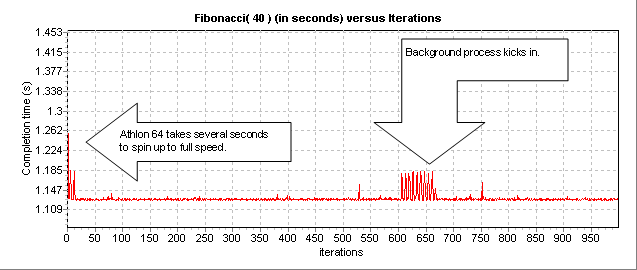
Finally, however, we did find another instance of throttling outside the two Sharp efficeon notebooks:
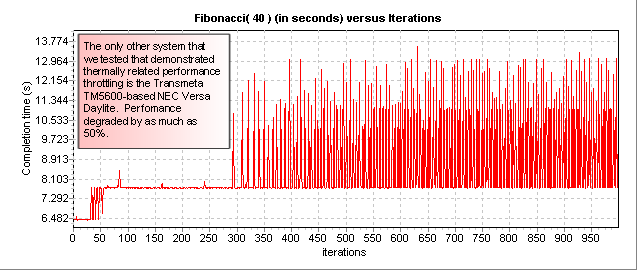
The only other system where we detected performance throttling was on another Transmeta-based notebook: the NEC Versa Daylite. This notebook uses a 600MHz TM5600.
That throttling only occurs on Transmeta-based notebooks strengthens our belief that Transmeta is deliberately understating the thermal requirements of their CPUs in order to sell them under the "fanless" premium designation.
===================================
Conclusion: Just Say "No" to Thermal Throttling!
It should be clear after reading this article that Transmeta microprocessors readily slow down to keep cool. The evidence is hard to argue with. As the efficeon heats up, performance goes down in lockstep with the clock speed that the efficeon itself is reporting. Putting the notebook in the deepfreeze causes performance and clock speed to gradually increase until the clock speed is steady at 1GHz. Moreover, Transmeta efficeons quickly throttle down from 1GHz to 833MHz even with relatively light loads. (We have seen the clock speed sink to 700MHz and even 533MHz under extremely heavy loads and with unfavorable ventilation.)
This behavior is unlike anything that we have found with any other processor from any other vendor.
You might have noticed a slightly angry tone in our full Transmeta efficeon review last month. Our dander was raised because of efficeon's in-your-face performance throttling that we discovered. Our further discovery of throttling in the Transmeta-equipped NEC Versa Daylite, leads us to believe that the throttling onus is on the Santa Clara, California-based chip designer and not the OEM. No system containing CPUs from other vendors ever throttled under our watch even when conditions were very harsh.
Transmeta appears to be trying to make acceptable a very fishy and misleading practice. In order to sell their CPUs in the high-dollar fanless market, Transmeta is apparently grossly understating the thermal design requirements for these chips and relying on performance throttling to keep these CPUs from burning up.
A piece of evidence that supports this belief is that while Transmeta claims 5W TDP (Thermal Design Power) for its 1GHz efficeons, the 1.2GHz efficeons (which Transmeta positions against 1.8GHz Dothans!) have a TDP of 25W! So for only a 20% boost in clock speed, efficeons demand 5x the power. This extreme power ramp rate only makes sense if the 1GHz efficeons are using throttling while the 1.2GHz efficeons (which still have not appeared on the American market) do not use throttling.
It is clear to us that the efficeon in the Sharp Actius MM20 is bundled with a thermal solution that is barely adequate for fanless operation at 833MHz. Transmeta should either specify more robust cooling solutions, or reduce the rating on the 1GHz efficeon to 833MHz.
Where does it end? Is it acceptable for a vendor to market a fanless 3.4GHz Prescott in a thin-and-light notebook only to rely on the system to immediately throttle down to 800MHz to keep the system from literally catching on fire whenever the user opens up Mozilla?
A couple of years ago, a group of Pentium 4 owners initiated a class action lawsuit against Intel for promoting misleading performance expectations. We believe that Transmeta's actions are potentially far more dubious than anything that Intel ever did when it comes to misrepresenting processor performance to the consumer. For instance, to Intel's credit, instances of P4 throttling have been, up to now, rare.
If consumers do not stand up against Transmeta's practice of utilizing performance throttling as demonstrated in this article, other CPU vendors will likely be forced to follow suit in order to remain competitive. If this comes to bitter fruition, in a few years CPU ratings could become completely meaningless and selecting a system could become like walking through a minefield.
===================================
Copyright 2004, Van Smith
===================================